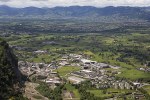News
Building – a bottomless pit?
In Austria only some 3% of all projects covered by environmental impact assessments (EIA) are currently rejected, with a further 1% refused immediate approval. From 2019 the EIA process may however be made quicker and easier: the «Site Development Law» will mean that, where major construction projects require an EIA but are considered to be relevant for the economic location, implementation can be accelerated without completion of the approval procedures. A construction project will be relevant for the economic location if it is of public interest. In such cases approval will be granted by the federal government – without the involvement of parliament or the public.
Criticism has come from all sides. Citizens, NGOs and federal state administrations all consider the draft law indefensible. Such a law would be contrary to Austria’s constitution, run counter to the European EIA Directive and contravene the Alpine Convention. Reinhard Gschöpf, Executive Director of CIPRA Austria, warns of the possible transnational effects: «If Austria starts a race to the bottom in reducing legal environmental and stakeholder rights, this would be a drama for the entire Alpine region.» In Switzerland, for example, a change to the Nature and Homeland Protection Law is currently being discussed that would more easily circumvent the national conservation status of certain landscapes and natural spaces in order to permit building there.
Highlighting the alternatives
The population of the Alps today requires three times as much space as was the case 50 years ago. The Alpine countries need strategies for resource-efficient land use. One way would be the skilful «recycling» of already built-up areas, allowing them to be reused or converted. Inward development and the exploitation of surface potentials, such as multi-storey buildings, also provide opportunities in addition to the much-needed slowing of the development spiral, thus allowing economical land use and a sensible reduction of large-scale projects.
Sources and further information:
www.umweltbundesamt.at/umweltsituation/uvpsup/uvpoesterreich1/uvpdatenbank/uvpstatistik (de), www.parlament.gv.at/PAKT/VHG/XXVI/ME/ME_00067/index.shtml (de), www.umweltdachverband.at/inhalt/umweltdachverband-standortentwicklungsgesetz-ist-der-groesste-gesetzesunfug-der-2-republik?ref=89 (de), www.sn.at/salzburg/politik/standortentwicklungsgesetz-umweltlandesrat-spricht-von-massivstem-rueckschritt-38901490 (de), www.vol.at/heftige-kritik-am-geplanten-standortentwicklungsgesetz/5898143 (de), https://eur-lex.europa.eu/legal-content/en/TXT/?uri=CELEX:32014L0052, www.alpconv.org/en/convention/protocols/default.html, www.bernerzeitung.ch/schweiz/standard/Es-drohen-Seilbahnen-Parkplaetze-und-Funparks-in-Schutzgebieten/story/11957254 (de), www.wwf.ch/de/medien/der-wwf-schweiz-sagt-nein-zum-verbau-der-wertvollsten-schweizer-naturschutzgebiete (de, fr, it)




